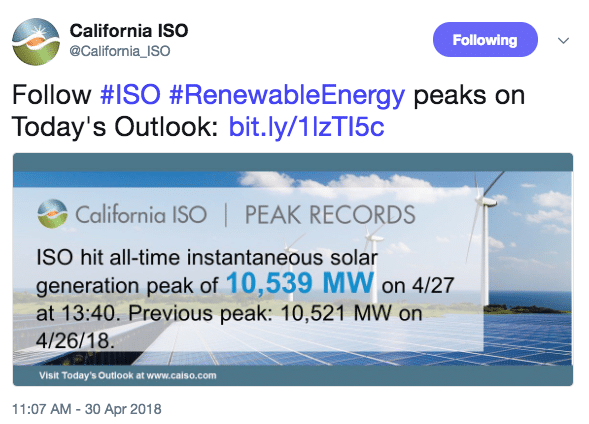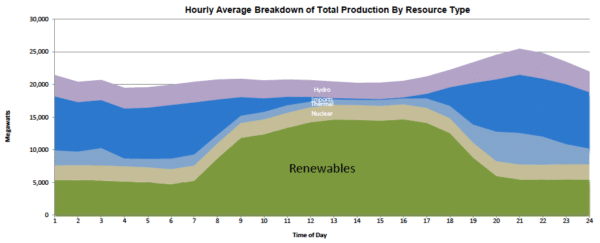California blew through a series of peak solar and renewable energy generation records last week, showing not only the increasing potential of the state to run on renewable energy, but also the work remaining to be done.
According to the California Independent System Operator (ISO), utility-scale solar generation reached 10,521 MW on Thursday April 26, as the first time it had surpassed 10.5 GW. On Saturday it peaked again 10,539 MW at 1:40 PM local time, a new record for the state.

California also hit a new record for the instantaneous portion of demand met by renewable energy on Saturday at 73%, just 15 minutes before the solar record, with solar and wind alone meeting 64% of demand.
What is even more remarkable is that this does not even count all of the solar. California had an estimated 6.6 GW of behind-the-meter solar as of the end of January 2018, which is not reflected in California ISO output data.
Over the full year 2017 renewable energy sources excluding large hydro plants represented 31% of California’s in-state electricity generation. With hydroelectric generation included, the total was more than half of all generation. However, the state also imports large volumes of electricity.
Improved flexibility (somewhat)
As California integrates these record levels of wind and solar, it is improving its ability to manage these levels by burning less gas and importing less power during peak renewable energy output. On April 28, California ISO reduced imports (dark blue) to 242 MW from 1 to 2 PM, the hour of greatest wind and solar output.

Likewise gas usage (light blue) was reduced to 804 MW during this hour, and ramped again to 4.8 GW from 8 to 9 PM. This low level is particularly remarkable as many gas plants need to run at a minimum level so that they are available for the evening ramp.
However, the state is showing less flexibility in other resources. Hydroelectric plants (purple) only reduced output slightly, falling to 2.3 GW during the middle of the day from 3.2 GW overnight. The Diablo Canyon nuclear power plant (tan) continued to run full bore, producing another 2.3 GW continuously.
Curtailment
And while nuclear and hydro generation were running, the state was wasting a portion of the output of wind and solar, with curtailment from eight in the morning to seven at night for what California ISO calls “economic” reasons. 1 to 2 PM was not even the highest period of curtailment, and over the 24-hour period 10 gigawatt-hours (GWh) of wind and solar generation was wasted.

The amount of curtailment is still low compared to overall generation. The 10 GWh of wind and solar curtailed on Saturday was less than 6% of the day’s wind and solar output, and 2018 year-to-date curtailment of 207 GWh represents around 1% of total renewable energy output.
California’s grid operator is also having greater success in trading electricity with grids in neighboring states, and this is helping somewhat. California ISO notes that it was able to avoid 66 GWh of wind and solar curtailment during Q1 alone due to rapid trading with five other regional grids through its energy imbalance market – while saving $42 million for participating members.
However, it is clear that in the future something will need to give.
Nuclear advocates have repeatedly attempted to paint their chosen technology as a victim of unreasonable bias by environmentalists. However, utility Pacific Gas & Electric Company has acknowledged that inflexible nuclear power plants do not fit in a future of increasing wind and solar, which requires a higher degree of flexibility from the rest of the generation fleet. As such it is planning to close Diablo Canyon by 2026.
It is less clear how the state will increase the flexibility of its hydroelectric fleet, or what the current barriers to this are. However, shifting of solar output to meet evening demand via mass deployment of energy storage – as is being done on the island of Kaua’i – and demand flexibility from electric vehicle charging could both play large roles.
This content is protected by copyright and may not be reused. If you want to cooperate with us and would like to reuse some of our content, please contact: editors@pv-magazine.com.









So, they are importing electricity from other grids while at the same time curtailing RE generation. That makes no sense to me.
Also, as mentioned – why can’t they shutdown the hydro and save it for when it is actually needed.
Hydro generation is flexible to some degree based on the size of the reservoir, but it must also take into account run-off, safe reservoir levels, and usually also ensure a certain minimum flow for downstream rivers. So it can’t really be ‘shut off’ per-say, just shifted around within a limited range.
Similarly, Nuclear plants cannot spool up and spool down on a dime. Reactors just don’t work that way, there is an enormous amount of energy momentum involved. They have to be run at a constant level of output.
So what is needed here more than anything else is utility-scale storage for excess solar generation during the day that could then be used to reduce the morning and evening ramps… pulling down the peaks and pulling up the bottoms, so to speak.
-Matt
And the electrical imports are…coal & nuclear